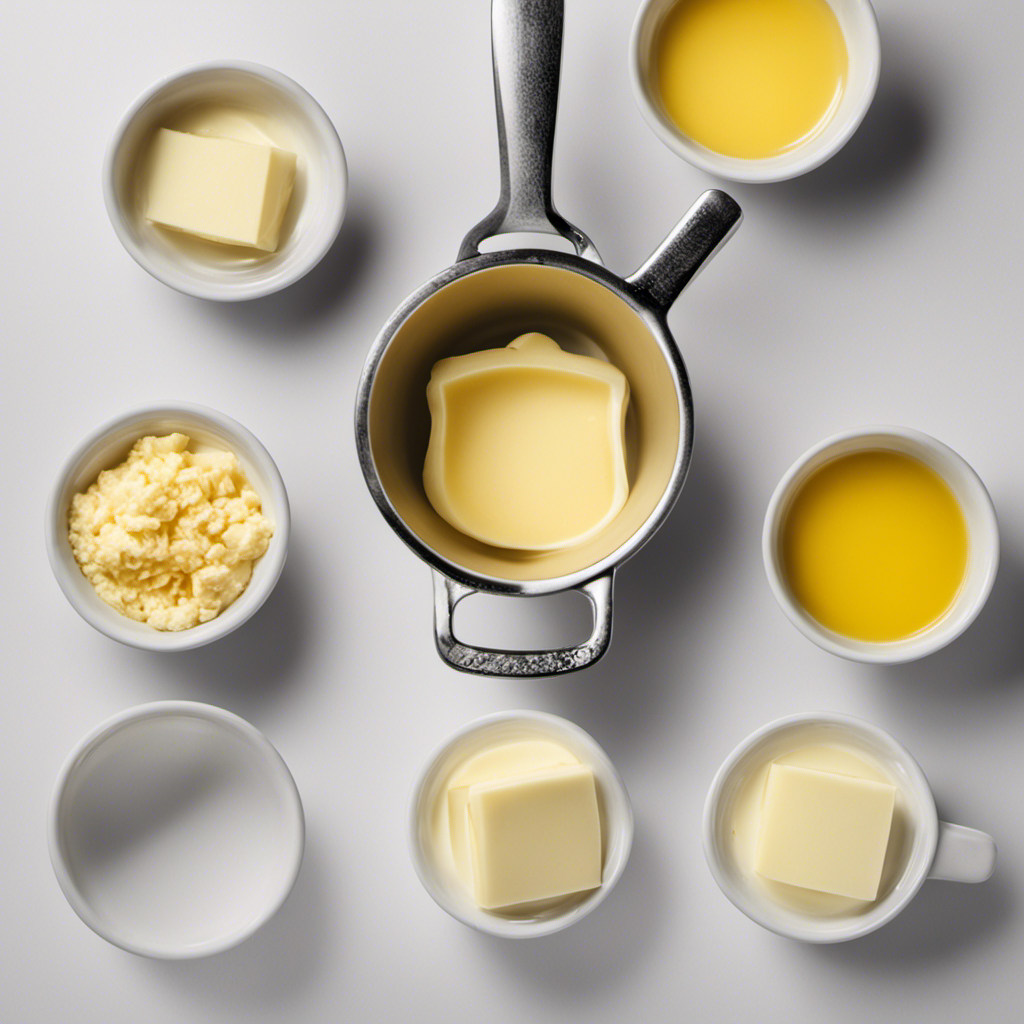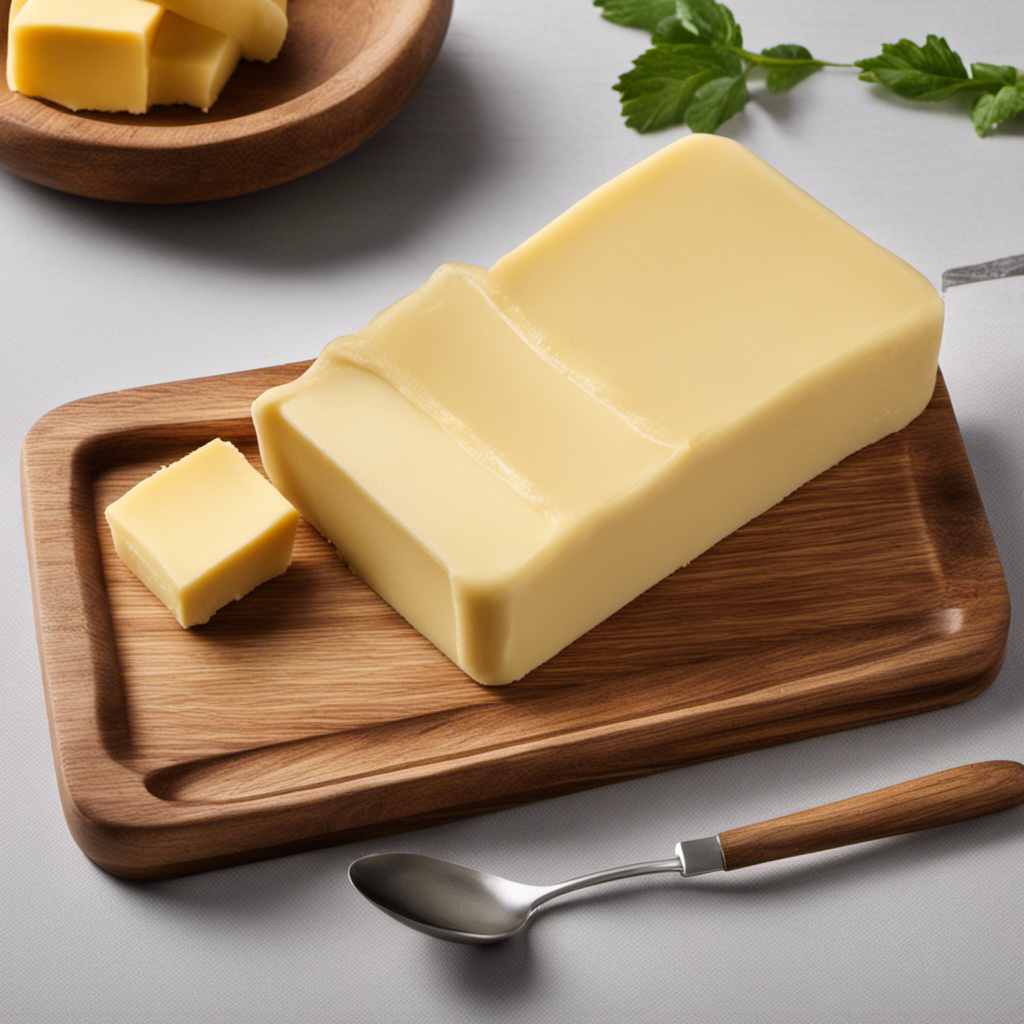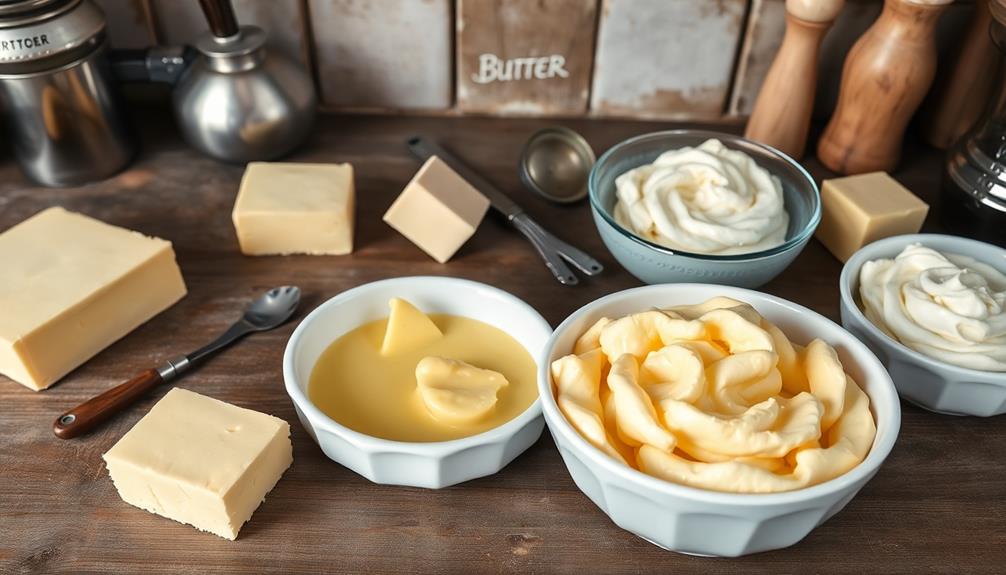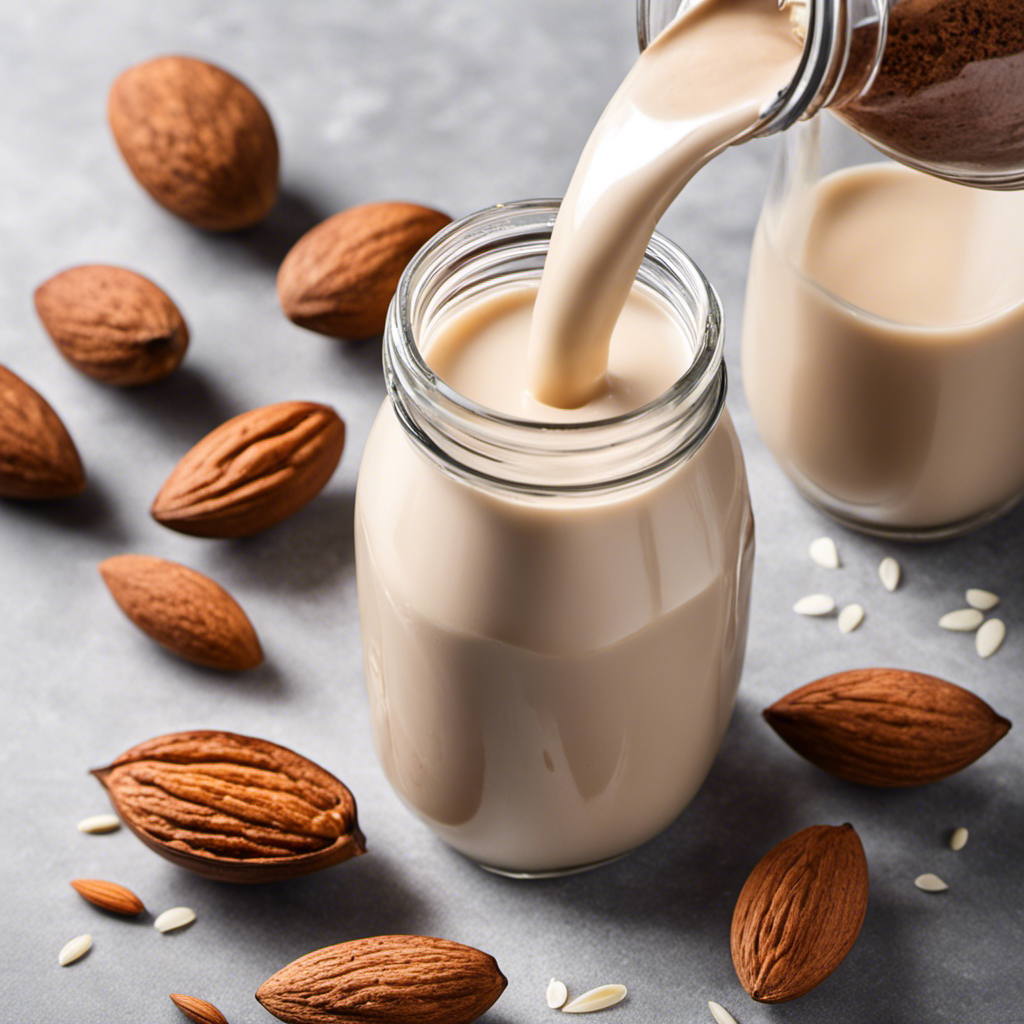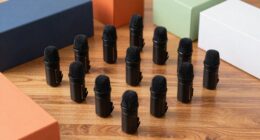Diving into the rich universe of butter, I find myself pondering a timeless query: How many tablespoons of this luscious treasure are contained within a simple quarter cup? Worry not, as I have undertaken a scientific journey to determine the exact number.
In this article, we shall explore the realm of butter measurements, converting those mysterious cups to the trusty tablespoon. So join me, dear reader, on this culinary voyage as we unravel the secrets of butter conversions and unlock the true potential of our recipes.
Key Takeaways
- Butter is commonly measured in tablespoons.
- 1/4 cup of butter is equivalent to 4 tablespoons.
- Accurate measurements ensure consistent results in recipes.
- Butter contains approximately 11 grams of fat per tablespoon.
Conversion Factors
There’s no need to worry about conversion factors when it comes to this question. When it comes to measuring ingredients, it’s important to have accurate measurements to ensure the desired outcome of a recipe.
In the case of butter, the common measurement is in tablespoons. However, if you only have a 1/4 cup measurement, you can easily convert it to tablespoons. One cup is equal to 16 tablespoons, so a 1/4 cup of butter would be 4 tablespoons.
It’s important to note that butter is high in fat and calories, so it should be consumed in moderation. If you’re looking for healthier alternatives, you can consider using spreads made from plant-based oils or avocado. These options provide healthier fats and can be a better choice for those watching their fat intake.
Understanding cup measurements is essential for accurate cooking and baking, so let’s dive into that next.
Understanding Cup Measurements
As a food scientist, it’s important to understand the conversion factors for butter, such as how many tablespoons are in a cup. Accurate measurements are crucial in the field of nutrition because they ensure precise calculations of macronutrients and calories.
However, there are common misconceptions when it comes to cup measurements. It’s essential to address these misconceptions to avoid any confusion or inaccuracies in our dietary assessments.
Butter Tablespoon Conversion
You’ll find that 1/4 cup of butter is equivalent to 4 tablespoons.
Butter is a common ingredient used in cooking and baking, known for its rich and creamy texture. It is primarily composed of fat, with approximately 80% of its content being fat. One tablespoon of butter contains around 14 grams of fat, providing about 100 calories.
It is important to measure butter accurately, especially when following recipes that require precise measurements. To measure butter, you can use a kitchen scale to weigh it in grams or ounces, or you can use measuring spoons to measure in tablespoons.
Butter has a melting point of around 90°F to 95°F (32°C to 35°C), which allows it to easily melt and incorporate into recipes.
When using butter, it is essential to consider its fat content and caloric value, as excessive consumption may have health implications. For a healthier alternative, you can consider using spreads or oils that are lower in saturated fat and calories.
Importance of Accurate Measurements
To ensure your recipe turns out perfectly, it’s crucial to measure ingredients accurately. Precise measurements play a vital role in achieving consistent and desirable outcomes in cooking and baking. Here are some reasons why accurate measurements are important in the kitchen:
-
Consistency: Accurate measurements ensure that the same amount of each ingredient is used every time, leading to consistent results.
-
Balance: Precise measurements help maintain the correct balance of flavors and textures in a recipe.
-
Texture: Accurate measurements ensure the desired texture of the final product, whether it’s light and fluffy or dense and chewy.
-
Nutrition: Accurate measurements are essential for calculating the nutritional content of a dish and following dietary guidelines.
The role of measuring tools cannot be overstated in achieving accurate measurements. Tools like measuring cups, spoons, and kitchen scales are indispensable in the kitchen. They provide precise measurements in grams, ounces, or tablespoons, ensuring accuracy in recipes.
Common Cup Measurement Misconceptions
Don’t be fooled by misconceptions about cup measurements; it’s important to understand the proper way to measure ingredients using cups. Common measurement errors can lead to inaccurate results and affect the quality of your recipes. One common misconception is assuming that one cup equals eight ounces. However, this is not always the case, especially when it comes to ingredients like butter. To convert butter to ounces, refer to the following table:
| Cups | Tablespoons | Ounces |
|---|---|---|
| 1/4 | 4 | 2 |
| 1/2 | 8 | 4 |
| 3/4 | 12 | 6 |
| 1 | 16 | 8 |
Butter Quantity in Tablespoons
When it comes to accurately measuring butter, converting from cups to tablespoons is a common practice.
As a food scientist, I understand the importance of precision in these measurements.
One tablespoon of butter is equivalent to 14.18 grams or 0.5 ounces, making it a reliable unit for accurate portion control.
Conversion to Tablespoons
There’s a simple conversion to figure out how many tablespoons of butter are in 1/4 cup. When it comes to baking conversions, knowing the exact measurement of ingredients is crucial. Here’s a quick breakdown to help you convert 1/4 cup of butter into tablespoons:
- 1/4 cup of butter is equivalent to 4 tablespoons.
Now, let’s delve into the nutritional analysis of butter. Butter is primarily composed of fat, with approximately 11 grams of fat per tablespoon. It is also high in calories, with around 100 calories per tablespoon.
While butter can add flavor and richness to recipes, it is important to consume it in moderation due to its high saturated fat content. For healthier options, consider using alternatives such as olive oil or avocado as substitutes for butter. These alternatives provide healthier fats and can be used in baking as well.
Keywords: conversion tips, baking conversions.
Accuracy of Measurement?
It’s crucial to accurately measure ingredients in baking to ensure the best results. As a food scientist, I understand the importance of measurement precision and converting units correctly. When it comes to butter, it’s essential to measure it accurately to achieve the desired taste and texture in baked goods. To help you understand the conversion, here’s a simple table:
| Measurement | Equivalent |
|---|---|
| 1/4 cup | 4 tablespoons |
Calculating Butter Measurements
To calculate butter measurements, you can easily convert 1/4 cup to tablespoons. The conversion factor is 1 cup = 16 tablespoons. Therefore, when you have 1/4 cup of butter, it is equivalent to 4 tablespoons.
Understanding tablespoon measurements is crucial for accurate recipe preparation. Here are some key points to consider:
- 1 tablespoon is equal to 14.2 grams of butter.
- Butter contains approximately 100 calories per tablespoon.
- The fat content in butter is about 11 grams per tablespoon.
- It is important to note that consuming excessive amounts of butter, due to its high fat content, may have implications for cardiovascular health.
With this knowledge, you can now confidently measure butter in tablespoons for your recipes.
Now, let’s move on to some handy kitchen conversion tips.
Handy Kitchen Conversion Tips
When you’re cooking, remember to use a kitchen scale for accurate measurements. Precision is key when it comes to butter measurement, especially in baking. Butter is often measured in tablespoons or cups, but it’s important to note that the conversion may vary depending on the recipe.
To ensure accuracy, I recommend using a kitchen scale to measure butter in grams or ounces. One tablespoon of butter weighs approximately 14 grams or 0.5 ounces. For a 1/4 cup of butter, you would need 4 tablespoons or 56 grams. It’s worth noting that butter is high in fat, with approximately 11 grams of fat per tablespoon.
If you’re looking for healthier alternatives, consider using unsweetened applesauce or mashed avocado as substitutes.
Now, let’s move on to common baking conversions.
Common Baking Conversions
For accurate baking measurements, remember that you can easily convert grams to ounces. When it comes to common baking conversions, it’s important to be precise and accurate to avoid common baking mistakes. Here are a few key conversions to keep in mind:
- 1 cup of flour is equivalent to 120 grams or 4.2 ounces.
- 1 tablespoon of butter is approximately 14 grams or 0.5 ounces.
- 1 teaspoon of baking powder is roughly 4 grams or 0.14 ounces.
- 1 ounce of chocolate chips equals about 28 grams or 0.98 ounces.
To ensure the accuracy of your measurements, use a kitchen scale for precise weighing. This will help you achieve consistent results in your baking. Remember, accuracy in measurements is crucial for the success of your recipes and to avoid any disappointments in the final outcome.
Frequently Asked Questions
Can I Substitute Margarine for Butter in Recipes?
Yes, margarine can be substituted for butter in recipes. Margarine offers benefits such as lower saturated fat content and fewer calories compared to butter. However, it’s important to check the specific recipe and adjust accordingly.
How Many Tablespoons Are in a Stick of Butter?
There are 8 tablespoons in a stick of butter. When it comes to substitutes for butter, it’s important to consider the benefits of using butter, such as its rich flavor and texture.
Can I Use Oil Instead of Butter in a Recipe?
Using oil instead of butter in a recipe is possible, but it may alter the taste and texture. Butter adds richness and flavor to dishes. However, substituting with coconut oil can provide health benefits due to its medium-chain fatty acids.
How Do I Convert Ounces of Butter to Tablespoons?
To convert butter measurements, you can easily convert from ounces to tablespoons. 1 ounce of butter is equal to 2 tablespoons. So if you have 4 ounces, you would have 8 tablespoons.
How Much Butter Should I Use if a Recipe Calls for Grams or Milliliters?
When converting grams to tablespoons or milliliters to tablespoons, it’s important to know the conversion rate. Consult a reliable source or use a conversion chart for accurate measurements.
Conclusion
In conclusion, there are 8 tablespoons of butter in 1/4 cup. This conversion factor is important to know when following recipes or measuring ingredients accurately.
It is crucial to understand cup measurements and how they relate to other measurements in the kitchen. Butter, which is high in fat content, should be used in moderation due to its potential health implications.
For a healthier alternative, considering using substitutes like olive oil or avocado. Remember, accurate measurements and nutritional analysis are key in creating delicious and nutritious meals.
